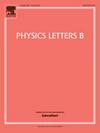具有 T7 × Z8 × Z2 对称性的 B - L 模型中的μ - τ 反射对称破缺
IF 4.3
2区 物理与天体物理
Q1 ASTRONOMY & ASTROPHYSICS
引用次数: 0
摘要
我们通过引入额外的单子标量和 I 型跷跷板机制,在具有 T7 对称性的 B-L 模型中提出了一种满足μ-τ 反射对称性的中微子质量矩阵纹理,其中涉及带电轻子和中微子质量以及轻子混合的层次模式。狄拉克和马约拉纳质量矩阵暗示了一种现实的轻子混合模式,其中μ-τ对称性被带电轻子部门的贡献所打破。建立了类尤卡娃耦合与观测到的中微子振荡参数之间的明确关系。带电轻子部门的汤川类耦合用三个带电轻子质量表示,而中微子部门的汤川类耦合用三个观测到的中微子混合角、两个中微子质量平方分裂和最轻中微子质量表示,它们的大小是同阶的。根据最近的实验数据,正常和倒置中微子质量等级以及较低和较高的倍频都符合所考虑的模型。本文章由计算机程序翻译,如有差异,请以英文原文为准。
The μ − τ reflection symmetry breaking in a B − L model with T7 × Z8 × Z2 symmetry
We suggest a neutrino mass matrix texture satisfying the reflection symmetry in a model with symmetry by introducing additional singlet scalars and invoking the Type-I seesaw mechanism in which the hierarchical patterns of charged lepton and neutrino masses and of lepton mixing are addressed. The Dirac and Majorana mass matrices hint for a realistic lepton mixing pattern in which the symmetry is broken by the contribution from the charged lepton sector. Explicit relations between the Yukawa-like couplings and the observed neutrino oscillation parameters are established. The Yukawa-like couplings in the charged-lepton sector are expressed in terms of three charged lepton masses whereas the Yukawa-like couplings in the neutrino sector are expressed in terms of three observed neutrino mixing angles, two neutrino mass-squared splittings and the lightest neutrino mass, whose magnitudes are in the same order. The considered model is satisfied for both normal and inverted neutrino mass hierarchies and for both lower and higher octants in the light of the recent experimental data.
求助全文
通过发布文献求助,成功后即可免费获取论文全文。
去求助
来源期刊

Physics Letters B
物理-物理:综合
CiteScore
9.10
自引率
6.80%
发文量
647
审稿时长
3 months
期刊介绍:
Physics Letters B ensures the rapid publication of important new results in particle physics, nuclear physics and cosmology. Specialized editors are responsible for contributions in experimental nuclear physics, theoretical nuclear physics, experimental high-energy physics, theoretical high-energy physics, and astrophysics.
 求助内容:
求助内容: 应助结果提醒方式:
应助结果提醒方式:


